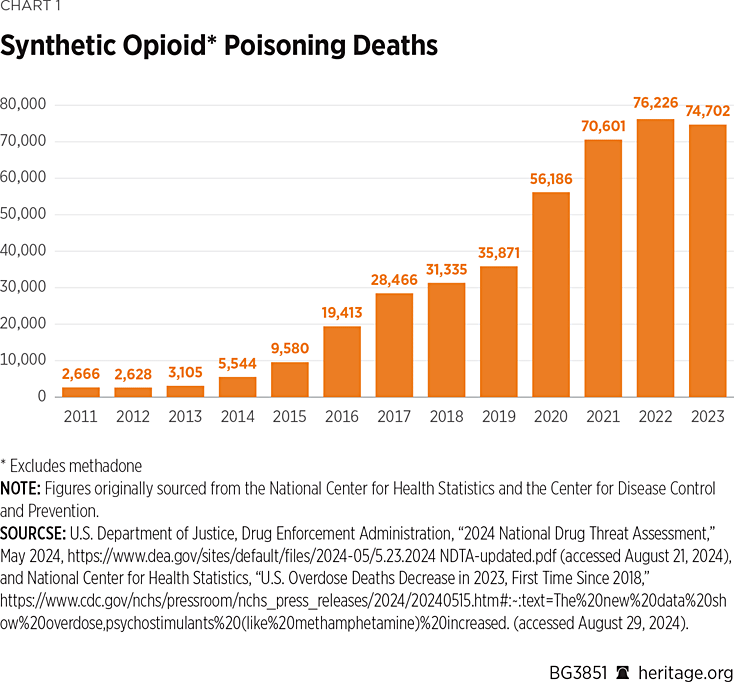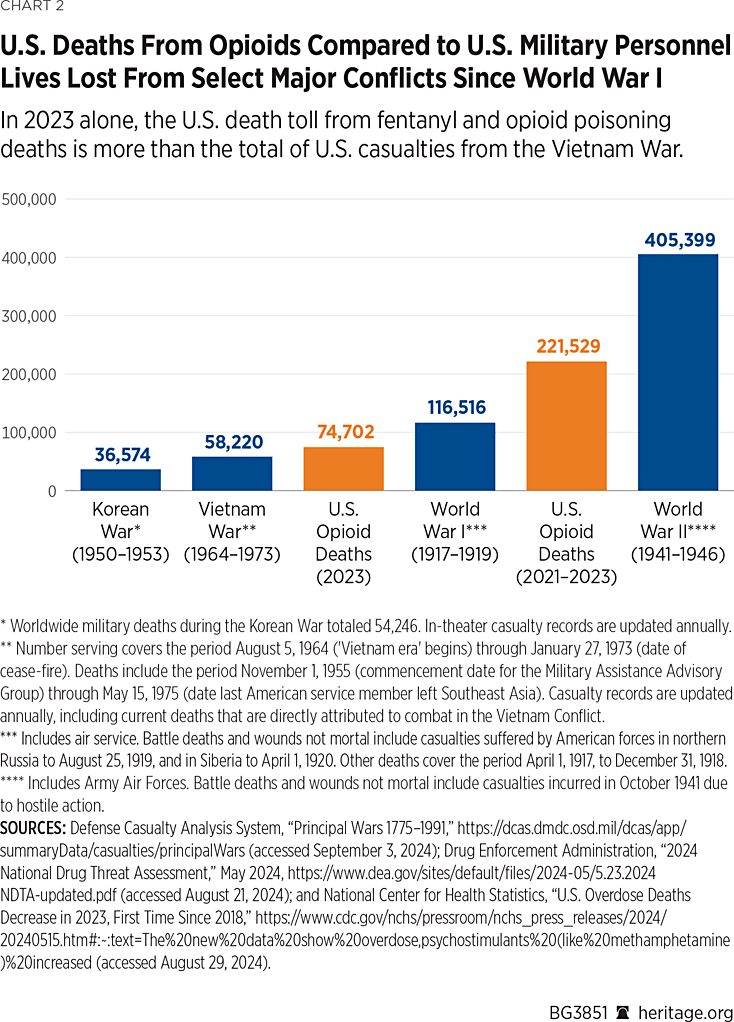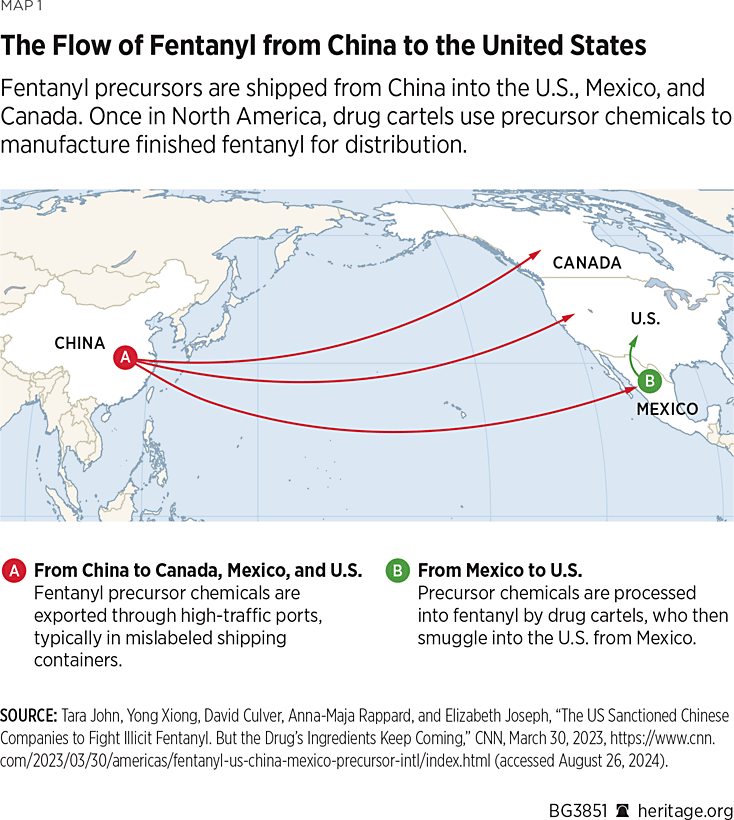Fentanyl is the “deadliest drug threat the United States has ever faced,”REF driving U.S. overdose deaths to a staggering 108,000 in 2023.REF Of those deaths, 75,000—or nearly three out of every four—were caused by synthetic opioids, primarily fentanyl.REF The nearly 200 Americans who continue to die every day from fentanyl overdoses represent an assault on the societal, political, and economic health of the United States, poisoning America from within. The fentanyl crisis also brings with it a destabilizing financial cost for the country and the U.S. health care system. In 2020 alone, the broader opioid epidemic cost the United States about $1.5 trillion—up 37 percent from 2017.REF

The United States struggles to reduce the massive inflow of fentanyl. The Drug Enforcement Agency (DEA) estimates that in 2021 alone, the U.S. government had seized enough fentanyl to kill every single American.REF At the heart of this crisis is an intricate global partnership bringing together America’s top geopolitical adversary and powerful transnational criminal organizations.
Mexican drug cartels play the most visible and well-publicized role in driving the fentanyl crisis. Across the Pacific Ocean, however, the People’s Republic of China (PRC) drives the destabilizing flow of fentanyl directly to the United States. Indeed, unknown to most Americans, the Chinese Communist Party (CCP) is actively funding, supporting, and pushing America’s most deadly drug threat in history. The combined forces of deadly Mexican drug cartels and hostile Chinese ambitions have delivered to the United States a destabilizing crisis and a death toll that each year eclipses the total of U.S. casualties from the Vietnam War.REF

The United States has failed to sufficiently address the fentanyl crisis with the urgency and attention it merits. Under the Biden Administration, Washington has turned a blind eye to the complicity of the CCP and the corrupt officials of the Mexican government, accepting empty commitments instead of taking necessary steps to confront the fentanyl crisis. Thankfully, the United States does not have to be a helpless victim of this weaponized drug crisis. It can—and should—confront the transnational fentanyl networks and their enablers while protecting the U.S. financial and health care systems from criminal exploitation.
China’s Culpability
Despite being an ocean away, Chinese precursor chemicals serve as the backbone of the supply chain that delivers deadly fentanyl throughout the United States. The problem has been metastasizing for years.
In December 2018, Chinese General Secretary Xi Jinping made a “commitment” to President Donald Trump that “China would schedule or control fentanyl.”REF In May 2019, China announced that “all fentanyl and analogues” would be placed on a control list, but illegal fentanyl producers were able to evade authorities.REF Yet, in the years that followed, China ceased conversations with the United States on countering opioid trafficking and relaxed enforcements on its biopharmaceutical industries, calling on the United States to “look squarely at its own problem instead of deflecting blame.”REF As it turns out, and perhaps to no surprise, fentanyl production has expanded—and with the CCP’s blessing.
In April 2024, the House Select Committee on Strategic Competition between the United States and the Chinese Communist Party released an investigative report detailing China’s role in America’s fentanyl epidemic.REF The investigation found that the CCP “directly subsidizes the manufacturing and export of illicit fentanyl materials and other synthetic narcotics.”REF
More specifically, the investigation found that “PRC chemical companies provide over 80% of methamphetamine precursors for cartels.”REF Precursor chemicals are then smuggled into Mexico either directly or through additional transit points in countries such as Germany, India, Turkey, and Guatemala.REF There are also instances of the United States directly receiving precursor chemicals that were then smuggled into Mexico to be manufactured into drugs before being smuggled back into the United States to be sold and the resulting profits being laundered.REF

Furthermore, among its many eye-opening findings is the existence of a tax rebate program for exporting fentanyl precursors that the CCP “never disclosed.”REF The committee found that, since at least 2018, the CCP’s tax rebate program incentivizes the export of 14 fentanyl analogues, many of which fall under a United Nations Treaty as Schedule I controlled substances.REF In 2020, the CCP even increased the rebates to 13 percent, which was “at that point the highest potential subsidy for any PRC exported product.”REF In 2024, the committee found that the CCP expanded the export subsidies despite such exports being illegal under both U.S. and PRC law.REF
As the committee investigated PRC websites that facilitated these illegal acts, the CCP appeared to deploy a “tripwire” that blocked U.S. users from accessing the sites.REF During negotiations with the Biden Administration, the PRC claimed that it “cannot control illegitimate actions” on precursor production, because “it cannot identify which manufacturers are exporting synthetic narcotics.”REF The committee’s investigation proved not only that the CCP knew it was facilitating precursor chemicals for fentanyl but that it also lied and attempted to cover its tracks.REF
The report also found that the CCP offered to fund the creation of synthetic narcotic manufacturing facilities, failed to pursue flagrant violations of its own substance laws, and notified Chinese synthetic narcotic manufacturers when the United States asked for assistance in order to allow them to adapt and operate undetected in the future.REF Chinese pharmaceutical companies and other vendors use marketplaces on the dark web to list and sell illicit narcotics, including the many fentanyl precursor and pre-precursor chemicals.REF
Chinese companies’ precursor chemicals primarily arrive to Mexico through air cargo, postal facilities, and maritime routes. Most precursor chemicals come through the first two options, though maritime shipment and ports are needed for industrial-scale chemical packages.REF Most chemicals then head for a cartel-controlled port in Mexico either directly or through an intermediary country.
Throughout this process, both the Chinese actors and the cartels must take measures to evade law enforcement and conceal precursor chemical shipments coming into Mexico.REF Tactics to conceal illegal trafficking include “hiding the chemicals among legitimate commercial goods, mislabeling the containers, using front companies to create the appearance of legitimacy, [and] shipping through third-party countries.”REF Efforts are not always successful. For example, the U.S. Department of Treasury sanctioned two Chinese associates for laundering “illicit drug proceeds belonging to the Sinaloa Cartel.”REF
There are other parallel entities being deployed from China to support these global fentanyl networks. As students at Liberty University have uncovered:
Chinese Triads play a critical role in the trafficking of fentanyl from China to the Western Hemisphere by establishing money laundering schemes, while simultaneously increasing China’s presence throughout the West through Private Security Companies (PSCs) and elite capture. The triads have established a relationship with various cartels and elite members throughout Latin America, Canada, and the United States.REF
Indeed, China’s more active role in fentanyl trafficking networks within the Western Hemisphere can be seen increasingly in Canada. In Toronto, for instance, Chinese criminal groups have established a more direct role in the smuggling, production, and distribution of fentanyl.REF
Despite the evidence that the CCP affirmatively promotes the export of illicit chemicals, the Biden Administration has sought to “work with” China on its complicity in the fentanyl epidemic.REF Nonetheless, the CCP refused to discuss the issue with the United States throughout most of the Biden Administration’s term.REF Instead, the CCP exploited American drug deaths for geopolitical leverage, convincing the Biden Administration to lift human rights sanctions in exchange for resuming counternarcotics discussions.REF
Following President Biden’s meeting with Xi in November 2023, the United States and China agreed to launch the U.S.-PRC Counternarcotics Working Group.REF China then issued “a notice to its domestic industry advising on the enforcement of laws and regulations related to trade in precursor chemicals and pill presses equipment” and began “taking law enforcement action against Chinese synthetic drug and chemical precursor suppliers.”REF Earlier in August 2024, China announced that it will “impose stricter oversight over the production and sale” of three chemicals used to produce fentanyl.”REF The U.S. Department of Treasury has also moved to block “all property and interests” in the United States of 25 Chinese individuals and entities that are “involved with the international proliferation of illicit drugs.”REF
However, past experience suggests that these diplomatic “victories” are likely to ring hollow. China uses fentanyl negotiations with the United States to seek concessions from the United States, potentially including the loosening of rules on technology sales.REF Furthermore, China’s announcements do not carry substantial costs for its chemicals industry, meaning that, as long as suppliers can evade rules—which has been documented for years, the production of fentanyl precursors will continue to prove profitable.REF If past patterns are repeated, then the Biden Administration’s fentanyl diplomacy is unlikely to curtail this deadly scourge.
Mexico to the United States
The DEA finds that Mexico’s cartels are “the main driver behind the ongoing epidemic of drug poising deaths in the United States.”REF Indeed, the majority of fentanyl trafficked into the United States comes through the U.S. southwest border with Mexico.REF Cartels leverage their sophisticated illicit infrastructure to manufacture, smuggle, and distribute fentanyl in the United States, including corrupt Mexican officials, money launderers, and complicit businesses.REF Cartels have easily plugged deadly fentanyl into the illicit networks that they have developed from decades of mass trafficking of drugs from marijuana to cocaine.
The Sinaloa and Jalisco cartels have come to dominate the supply of fentanyl into the United States with the aid and cooperation of well-connected Chinese elites, corporations, and criminal groups.REF Chinese precursor chemicals reach Mexico often at a port or other shipping facility. Cartels bribe corrupt officials at Mexican ports to ensure their ability to access and remove the chemicals. Cartel-linked shipping/trucking companies then transport precursor chemicals to inland locations in Mexico. Eventually, these chemicals are brought to clandestine fentanyl production sites in Mexico, which can be located throughout the country, including in Mexico’s capital.REF
According to the DEA, the cartels then turn again to a “web of networks to smuggle drugs into the United States, to include air and sea cargo, vehicular and pedestrian traffic, border tunnels, and stash houses on both sides of the border.”REF The cartel networks in the United States include illicit infrastructure and allied drug trafficking gangs that allow the cartels to further direct distribution within the United States. This is also key to the smuggling and laundering of illicit drug proceeds, which is an essential and sophisticated element of fentanyl trafficking networks. From bulk cash smuggling and shell companies to real estate fraud, the cartels deploy a variety of methods to repatriate illicit drug money and continue to fuel fentanyl trafficking networks.REF
The money laundering leg of fentanyl trafficking networks shows that China’s role in the fentanyl crisis does not end at Mexico’s ports. Indeed, Chinese businesses and money launderers maintain an active presence within MexicoREF and even in the United States.REF Chinese-owned businesses in North America, for example, have become common partners for money launderers using “mirror swaps.” This increasingly dominant money laundering typology avoids the direct movement of drug money from the United States to Mexico and instead goes through the Chinese financial system, where the Chinese government is able to once again block enforcement by the United States.REF So far, the Counternarcotics Working Group is unlikely to alter the behavior of the Chinese financial system, as China’s recent regulatory announcements still do not impose strict requirements for companies to verify that they are not doing business with the cartels.REF
Mexico’s Complicity
The cartels are able to operate vast drug production and smuggling operations in Mexico thanks to the complicity of corrupt Mexican officials. The challenge of narco-corruption in Mexico has grown exponentially over the past several years, making it so that the Mexican government is, in practice, no longer a dependable good-faith partner to the United States on fentanyl trafficking. Corruption permeates local security forces in Mexico, with substantial elements of the Mexican police force on cartel payrolls. The rapid militarization of Mexican security policy has done little to alleviate the challenge of corruption. Indeed, even top military officials have been implicated in cartel corruption, including a recent Mexican minister of defense.REF
Under the administration of President Andrés Manuel López Obrador, the Mexican government has largely shed the pretext of seeking to combat the Mexican cartels. Instead, President López Obrador’s “hugs, not bullets” strategy has limited operations against the drug cartels and gravely undermined the capacity of U.S. law enforcement to operate in Mexico.REF President López Obrador even condemned the recent peaceful surrender of a top cartel kingpin and his accomplice to authorities in the United States.REF
The Biden Administration has refused to significantly pressure the Mexican government to take a more active role in combating the deadly cartel threat housed within its borders. Instead, the United States has accepted empty commitments and false efforts by Mexican security forces. For example, the Mexican government has made a show of recently ramping up targeting of clandestine drug labs. Closer scrutiny, however, revealed that of the 527 labs raided by the Mexican military in the first seven months of 2023, fewer than 5 percent were active.REF The predictable results of Mexico’s permissive environment for the cartels have manifested themselves in the form of a dramatic death toll of both U.S. and Mexican citizens.REF
Recommendations
An effective U.S. strategy to combat the international fentanyl trafficking industry should begin with the recognition that the United States lacks good-faith partners in both the Chinese and Mexican governments. Therefore, the United States should take aggressive and proactive measures that protect the U.S. trade, financial, and health care systems from criminal exploitation while also deploying U.S. intelligence and law enforcement to target these illicit networks. Such an effort will require great political will and an unyielding commitment to safeguarding the citizens of the United States from this weaponized narco-crisis.
To hold China accountable for its role in America’s fentanyl crisis, the United States should:
- Go after fentanyl money. Efforts should include increasing the number of financial investigators at the U.S. Treasury Department, tasking additional financial investigators at the Treasury Department to target and uncover Chinese and Mexican fentanyl traffickers, implementing beneficial ownership transparency laws, increasing the number of forensic accountants throughout the intelligence community, and increasing penalties for financial institutions and money transfer services for facilitating money laundering for fentanyl traffickers.
- Expose China’s criminality. The President should task U.S. intelligence agencies to uncover and publicly expose Chinese involvement in global fentanyl trafficking networks, including their presence in North America. Sensitive intelligence on Chinese criminal activity should be shared with trusted partner nations, including transit nations in Europe and Asia.
- Expose Mexico’s complicity: The United States should task financial investigators to uncover narco-corruption in Mexico to reveal the depths of the crisis. The United States should then unleash sanctions on Mexican officials, naming and shaming them while cutting them off from the United States and its financial system.
- Protect America from China’s corrupt pharmaceutical and chemical industries. In multiple cases, Chinese front companies created to export fentanyl precursors have had links to otherwise legitimate Chinese pharmaceutical companies, enabling fentanyl traffickers access to chemicals and expertise. The United States should place new tariffs on Chinese pharmaceutical imports and increase non-tariff inspection and transparency requirements for Chinese pharmaceutical imports. At the same time, the United States should facilitate the reshoring and nearshoring of U.S. pharmaceutical supply chains away from China to the United States and its allies and partners, including areas with a competitive advantage, such as the U.S. territory of Puerto Rico.
- Secure U.S. customs and trade vulnerabilities exploited by fentanyl traffickers. De minimus shipments are shipments that are granted a tax- and duty-free exception if they are valued less than $800.REF From 2016 to 2020, the value of de minimis imports from China to the United States increased from $1.82 billion to $46.39 billion.REF This significant increase limits U.S. Customs and Border Protection’s ability to identify and interdict high-risk shipments that may contain narcotics.REF Additionally, in 2023, a Chinese national was indicted for shipping over 2,000 kilograms of fentanyl precursor chemicals from China into the United States and on to Mexico, approximately through 100 separate shipments, “by declaring them to have a de minimus value.”REF Congress should consider enhancing screening services for packages and shipments that can increase seizures of hazardous packages. Congress should also consider scoping reforms and enforcement mechanisms that can address the abuse of de minimis shipments. Potential reforms include creating a discrete list of foreign adversaries, which would include China, that receive a substantially reduced de minimis threshold.
Conclusion
America faces a dire threat in the form of the fentanyl crisis, one that is fundamentally different from long-standing U.S. illegal narcotics challenges due to its significant number of U.S. deaths and its direct origins from the CCP. U.S. adversaries are establishing a new avenue of asymmetric warfare against the American people through which they can launch destabilizing actions against the United States.
Simply put, neither Beijing nor Mexico City will confront their transnational fentanyl networks without U.S. action and pressure. If the U.S. government continues to passively accept the fentanyl crisis as simply another illicit drug challenge and fails to prevent the CCP from facilitating this deadly trade, hundreds of thousands—if not millions—of Americans are at risk of losing their lives.
Only by mustering political will, effective resources, and a sound strategy can the United States combat this effort to destabilize and weaken the country. The solutions begin with recognizing China’s culpability in driving the crisis and, ultimately, prioritizing efforts that directly target malign Chinese actors. Similarly, the United States should recognize the complicity of corrupt Mexican officials in supporting the cartels driving fentanyl over the U.S. border. These efforts to hold China and Mexico accountable will be politically and economically costly, but the price will pale in comparison to the toll on American communities and the millions of Americans lives that stand to be lost to fentanyl in the years that come.
Andrés Martínez-Fernández is Senior Policy Analyst for Latin American in the Douglas and Sarah Allison Center for National Security at The Heritage Foundation. Andrew J. Harding is Research Assistant in the Asian Studies Center. The authors recognize and credit Liberty University’s Analytical Support Initiative (LASI) for its research on this topic.




